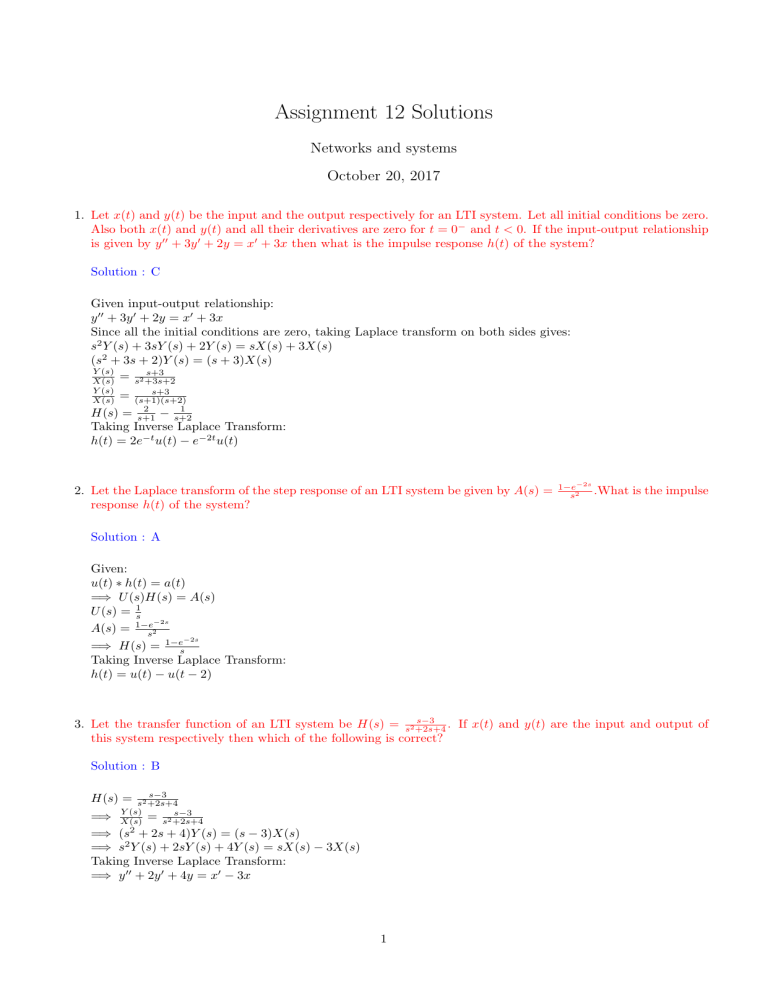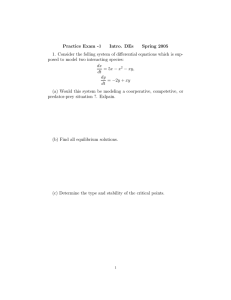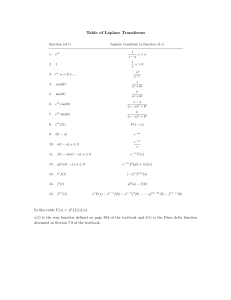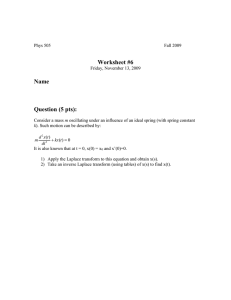
Assignment 12 Solutions Networks and systems October 20, 2017 1. Let x(t) and y(t) be the input and the output respectively for an LTI system. Let all initial conditions be zero. Also both x(t) and y(t) and all their derivatives are zero for t = 0− and t < 0. If the input-output relationship is given by y 00 + 3y 0 + 2y = x0 + 3x then what is the impulse response h(t) of the system? Solution : C Given input-output relationship: y 00 + 3y 0 + 2y = x0 + 3x Since all the initial conditions are zero, taking Laplace transform on both sides gives: s2 Y (s) + 3sY (s) + 2Y (s) = sX(s) + 3X(s) (s2 + 3s + 2)Y (s) = (s + 3)X(s) Y (s) s+3 X(s) = s2 +3s+2 Y (s) X(s) s+3 = (s+1)(s+2) 1 2 − s+2 H(s) = s+1 Taking Inverse Laplace Transform: h(t) = 2e−t u(t) − e−2t u(t) 2. Let the Laplace transform of the step response of an LTI system be given by A(s) = response h(t) of the system? 1−e−2s .What s2 is the impulse Solution : A Given: u(t) ∗ h(t) = a(t) =⇒ U (s)H(s) = A(s) U (s) = 1s −2s A(s) = 1−es2 −2s =⇒ H(s) = 1−es Taking Inverse Laplace Transform: h(t) = u(t) − u(t − 2) s−3 . If x(t) and y(t) are the input and output of 3. Let the transfer function of an LTI system be H(s) = s2 +2s+4 this system respectively then which of the following is correct? Solution : B s−3 s2 +2s+4 Y (s) s−3 X(s) = s2 +2s+4 2 H(s) = =⇒ =⇒ (s + 2s + 4)Y (s) = (s − 3)X(s) =⇒ s2 Y (s) + 2sY (s) + 4Y (s) = sX(s) − 3X(s) Taking Inverse Laplace Transform: =⇒ y 00 + 2y 0 + 4y = x0 − 3x 1 s 4. Let B(s) = s2 +5s+6 be the Laplace transform of the response of an LTI system to the input tu(t). What is the response obtained on applying a unit step u(t) to the system? Solution : D Given: r(t) ∗ h(t) = b(t) =⇒ R(s)H(s) = B(s) R(s) = s12 s B(s) = s2 +5s+6 3 s =⇒ H(s) = s2 +5s+6 Y (s) = U (s)X(s) s2 =⇒ Y (s) = s2 +5s+6 Taking Inverse Laplace Transform: =⇒ y(t) = 4e−2t u(t) − 9e−3t u(t) + δ(t) 5. What is the sum of the poles and zeros of a system whose characteristic function is H(s) = Solution : C s2 −2s+2 (s2 −1)(s3 −3s+1) Sum of the roots of a polynomial of degree n in s is given by: -1*Coefficient of sn−1 divide by Coefficient of sn Thus, sum of zeros = −1 ∗ −2 1 =2 And sum of poles = 0 + 0 = 0 Thus, Sum of poles and zeros = 2 6. To a system whose characteristic function is given byH(s) = s2 + 2, an input x(t) = cos(2t) is applied. What is the forced response of the system? Solution : B Forced response = |H(2j)| cos(2t + 6 H(2j)) H(2j) = (2j)2 + 2 = −2 Forced response = | − 2| cos(2t + 6 − 2) = 2 cos(2t + π) = −2 cos(2t) 7. To a system whose frequency response is given by H(jω) = jω, an input x(t) = cos(t) is applied. Find the forced response of the system. Solution : C Forced response = |H(j1)| cos t + 6 H(j1) H(j1) = j Forced response =cos(t + π/2) = − sin(t) 8. When a voltage u(t) is applied to a circuit (all initial conditions zero), the current measured is 2e−t + 3e−4t u(t). Find the current when a voltage v(t) = δ(t) is applied (impulse response of the system). Solution : A u(t) −→ 1s 2 3 2e−t + 3e−4t u(t) −→ s+1 + s+4 Let h(t) be the impulse response of the system, then 2 3 H(s) 1s = s+1 + s+4 2 2s 3s 2 12 H(s) = s+1 + s+4 = 5 − s+1 − s+4 h(t) = 5δ(t) − (2e−t + 12e−4t )u(t) 9. When a voltage u(t) is applied to a circuit (all initial conditions zero), the current measured is 2e−t + 3e−4t u(t). Find the steady state current when an input voltage v(t) = cos(t)u(t) is applied. Solution : A 2s 3s From the last question H(s) = s+1 + s+4 29 H(j1) = 20 17 + 17 j |H(j1)| = 2.07 6 H(j1) = 0.96 rad Steady state response = |H(j)| cos(t + 6 H(j)) = 2.07 cos(t + 0.96)u(t) 10. When a voltage u(t) is applied to a circuit (all initial conditions zero), the current measured is 2e−t + 3e−4t u(t). Find the current when an input voltage v(t) = δ(t) + 4u(t) is applied. Solution : C Current Current Current Current when when when when δ(t) is applied = 5δ(t) − (2e−t + 12e−4t )u(t) u(t) is applied = (2e−t + 3e−4t )u(t) δ(t) + 4u(t) is applied = 5δ(t) − (2e−t + 12e−4t )u(t) + 4 (2e−t + 3e−4t )u(t) δ(t) + 4u(t) is applied = 5δ(t) + 6e−t u(t) 3




